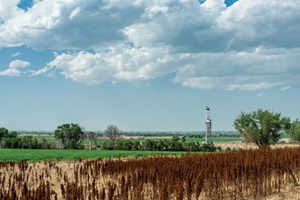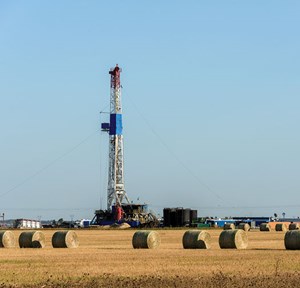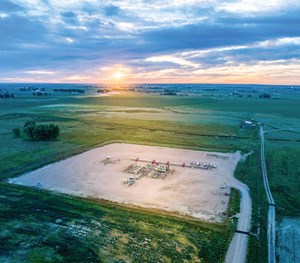Shaletech: Niobrara-Codell Shales

For at least two years, operators in Colorado’s Denver-Julesburg (DJ) basin won’t have to constantly look over their shoulders for petition-wielding activists pressuring the state to put their rigs and frac spreads out of business.
A gubernatorial covenant means development of the Niobrara and Codell shales within the state’s jurisdiction can proceed without any industry-related initiatives put before voters over the next two election cycles. After striking a deal with both environmental and industry organizations, Democratic Gov. Jared Polis said in a widely circulated op-ed on July 24, “As governor, I will actively oppose ballot initiatives related to oil and gas extraction in 2020 and 2022 from both sides.”
The political armistice, however, appears a bit irrelevant today, given that the pandemic-provoked demand and price destruction have succeeded where the anti-oil-and-gas crowd failed. Only four rigs (Fig. 1) have been consistently active in the triple-bench Niobrara and underlying Codell play between June 26 and Sept. 11, according to Baker Hughes, with nearly all activity, as it is, concentrated in the far-reaching Wattenberg field of Weld County, Colo.

Similarly, oil and gas production from the Niobrara region, which stretches into Wyoming, is expected to drop to 605,000 bpd and 5,128 MMcfd, respectively, during October, according to U.S. Energy Information Administration (EIA) estimates, Fig. 2. By comparison, EIA data show oil production of around 763,000 bpd in October 2019, joining once-constrained gas production of 5,579 MMcfd. Gas production has been largely freed up, thanks to DCP Midstream’s expanded DJ takeaway network, which before year’s end will include the new Latham II processing facility. The start-up of the facility will give DCP total basin-wide capacity of around 1.6 Bcfd.
As in unconventional plays elsewhere, most of the handful of operators still holding Niobrara-Codell positions have either shut-in production or built up their inventories of drilled-but-uncompleted (DUC) wells in anticipation of a commodity price improvement. The latest EIA data available show a cumulative 481 DUC wells in the Niobrara region in August, up from 457 DUC wells in January.
Market conditions notwithstanding, the two-year legislative reprieve was met with a collective sigh of relief. “From an operational standpoint in Colorado, we’re seeing some of the regulatory and midstream headwinds that we faced in the past dissipating, allowing us to project the safe and responsible development of our high-return Wattenberg asset with more clarity and certainty,” says Lance Lauck, executive V.P. of corporate development and strategy for PDC Energy Inc., which with a single rig, is among the most active operators in the DJ basin.

“WAR’S OVER”
The truce, for now, cools the simmering anti-development campaigns that have long divided Weld County, which, at once, accounts for nearly 90% of Colorado’s production, but has been squarely in the crosshairs of regulatory apostles. The heavily populated Front Range has been the epicenter of the electoral battles, putting a premium on leases in the county’s more rural and unincorporated areas.
Noting that the governor has “reaffirmed that the oil and gas wars are over,” DCP Midstream President and CEO Wouter van Kempen said in an Aug. 7 call, “we’re excited to see the potential of the DJ basin now fully unleashed. We said for years that our producers are drilling some of the best rock, with the strongest returns, right here in Colorado.”
The last major piece of legislation was enacted in 2019, with the passage of the sweeping Senate Bill 19-181, which among other provisions, gives county and municipal governments the power to first approve or reject drilling plans within their boundaries.
Though new state legislation is off the table, the results of next month’s U.S. presidential election could deliver a blow, as Democratic candidate Joe Biden has vowed to ban fracing on federal lands. If enacted, a prohibition would especially hit the comparably relaxed regulatory climate in Wyoming, where some 43 million acres of mineral rights are controlled by the U.S. Bureau of Land Management (BLM).
Holding a cumulative 472,000 net acres in the Wyoming DJ and Powder River basins, EOG Resources, Inc. would appear to be particularly exposed. While questioning the fiscal viability of putting public acreage off-limits, CEO Bill Thomas said EOG’s Wyoming operations would be largely unaffected regardless, given the company’s substantial stash of “ premium quality drilling potential” on non-federal land. “In 2019, over $2 billion of revenue was paid out to over 35 states. So, it’s not an easy thing to change significantly the federal drilling potential,” he said of the proposed ban.
In an entirely front-loaded 2020, EOG planned to put 15 Niobrara-Codell wells on production in the Wyoming DJ, all in the first half of the year. Thirty wells are scheduled to be turned-in-line this year in the multi-zone Power River basin—two in the second half of 2020—where along with the Niobrara, EOG also targets the Mowry shale and the overlying Parkman and Turner sands.
TALE OF THE TAPE
Meanwhile, nine months removed from its acquisition of SRC Energy, PDC Energy closed out the second quarter with 27 new drills and 52 wells turned-in-line in the Wattenberg, the company’s single largest asset. Production averaged roughly 161,000 boed at medium lease operating costs (LOE) of $1.88/boe.
PDC also operates in the Delaware basin, but a head-to-head comparison after the second quarter shows the Niobrara far ahead in every conceivable metric. PDC drilled but one well in the Permian asset with seven put on production at a LOE of $3.19/boe. Quarterly Delaware production averaged around 28,500 boed. Total costs in the Wattenberg amounted to approximately $400/ft, compared to $850/ft for its West Texas and southeastern New Mexico counterpart.
As prices nosedived in the first quarter, PDC curtailed 15% of cumulative oil volumes (around 11,000 bpd), but was “essentially un-curtailed” in both plays by the end of the second quarter, said retiring COO Scott J. Reasoner.
The company will continue running one rig throughout the year and planned to re-start completions late in the third quarter. “Our team is excited to get back to testing new completion designs and well spacing initiatives, in an effort to maximize both our value per well and total value field well,” he said.
PDC closed the estimated $1.7-billion all-stock acquisition of SRC on Jan. 14, increasing its Niobrara position to 182,000 net contiguous acres in the Weld County core.
Elsewhere, with the acquisition by Chevron waiting in the wings, Noble Energy Inc., likewise, ran a single rig in the DJ basin in the second quarter, drilling 16 wells and completing four wells. The 144,000 boed produced in the second quarter equaled just over 58% of the company’s total U.S. onshore production, Fig. 3. Similarly, the DJ accounted for roughly 80% of the 30,000 boed curtailed during the quarter.
Chevron’s pending $5-billion acquisition will include Noble’s 336,000-net-acre position in the Weld County core.
Occidental Petroleum Corp, for another, is waiting out the market, with no immediate plans to grow production in the 400,000-net-acre Wattenberg asset acquired in last year’s gritty Anadarko deal. “In the DJ basin, we will begin completing a select group of high-return, drilled-but-uncompleted wells,” said President and CEO Vicki Hollub said in an Aug. 12 call. “While our Rockies production will now be lower this year, the remaining barrels are higher-margin.”
As part of efforts to reduce the debt assumed in the $55-billion Anadarko acquisition, Oxy is selling more than 5 million land grant mineral and surface acres in Colorado, Wyoming and Utah. The estimated $1.33-billion acquisition by Orion Mine Finance is expected to close in the fourth quarter.
“We will retain our core oil and gas assets in the Rockies, including the prolific DJ basin in Colorado and the highly prospective Powder River basin in Wyoming,” Hollub said when the deal was announced on Aug. 19.
DUC BUILD-UP
Oxy is not alone in relying on DUCs, rather than new wells, to bring on production when the time is right. After suspending all new activity, HighPoint Resources Corp, for one, has a more than 20-well DUC inventory “that will allow us to quickly resume completion activity, if prices warrant,” CEO Scot Woodall said on Aug. 4.
The pure-play operator produced just under 2.9 MMboe, total, in the second quarter, up only 1% from the year-ago quarter. The company expects cumulative production to drop in the third quarter from between 2.5 MMboe and 2.6 MMboe.
HighPoint controls 58,300 largely rural net acres, taking in the northeastern quadrant of the Wattenberg and Hereford fields in the unincorporated Fox Creek area of south-central Colorado. Nine extended-reach (avg. 10,000 ft) wells, completed with high fluid intensity and placed on flowback in NE Wattenberg in May and June, averaged 75-day oil production of around 35,000 bpd. The company said the five wells completed and placed on flowback in the Fox Creek area during the second quarter represented Hereford field’s “highest-performing wells to date.”
Given the more developed infrastructure that has helped reduce total well costs to around $4.3 million, the Wattenberg asset is likely to get first dibs when drilling and completions resume, Woodall says. “When you think about the highest capital efficiency place right now in the portfolio, it’s probably Northeast Wattenberg, kind of based on that infrastructure. And so, I would suspect that it will most likely start there” he said. “And, then coupled with the EUR (estimated ultimate recoveries) performance, makes the DUC start looking pretty attractive in that $40 (bbl) range.”
The future looks more uncertain for Extraction Oil and Gas, Inc, which on June 15 joined a growing parade of shale operators in the bankruptcy court. Before filing for Chapter 11 protection, Extraction laid down its two operated rigs and one completion crew in the middle of April. “Aside from possibly completing one drilled-but-uncompleted pad in Greeley during the second half of the year, we are delaying further operating, drilling and completion activity until prices improve,” President and CEO Matt Owens said in a final call on May 11.
Extraction operates exclusively in a largely contiguous Wattenberg asset comprising roughly 289,000 net acres, where the company had targeted the Niobrara and Codell. Early in the second quarter, Extraction believed it was on pace to reduce total costs for Niobrara and Codell wells with more than 10,000-ft reaches to $4.1 million/well and $3.8 million/well, respectively, which would have been the lowest well costs since the company was formed in 2012.
Until the “continued uncertainty in the commodity markets,” intervened, Extraction drilled 34 gross (25 net) wells with an average lateral length of approximately 2.3 mi in the first quarter and completed 28 gross (23 net) wells, with another 13 gross (12 net) wells put online.
Elsewhere, EOG’s Thomas said the current business climate has forced a revision of what qualifies an asset to fall within the company’s exacting premium drilling portfolio, which includes the Wyoming Niobrara-Codell play. The strategy holds that any well drilled must deliver a minimum 30%, direct, after-tax rate of return on a flat $40/bbl oil price. “In this downturn, we have raised the return bar even higher by using $30 oil instead of $40 to calculate our 30% rate of return,” he said.

- Shale technology: Bayesian variable pressure decline-curve analysis for shale gas wells (March 2024)
- U.S. oil and natural gas production hits record highs (February 2024)
- Rig electrification drives down emissions, bolsters efficiency while improving onshore drilling economics (October 2023)
- What's new in production (August 2023)
- Mobile electric microgrids address power demands of high-intensity fracing (July 2023)
- Utilizing electronic data captured at the bit improves PDC design and drilling performance (July 2023)
- Applying ultra-deep LWD resistivity technology successfully in a SAGD operation (May 2019)
- Adoption of wireless intelligent completions advances (May 2019)
- Majors double down as takeaway crunch eases (April 2019)
- What’s new in well logging and formation evaluation (April 2019)
- Qualification of a 20,000-psi subsea BOP: A collaborative approach (February 2019)
- ConocoPhillips’ Greg Leveille sees rapid trajectory of technical advancement continuing (February 2019)



